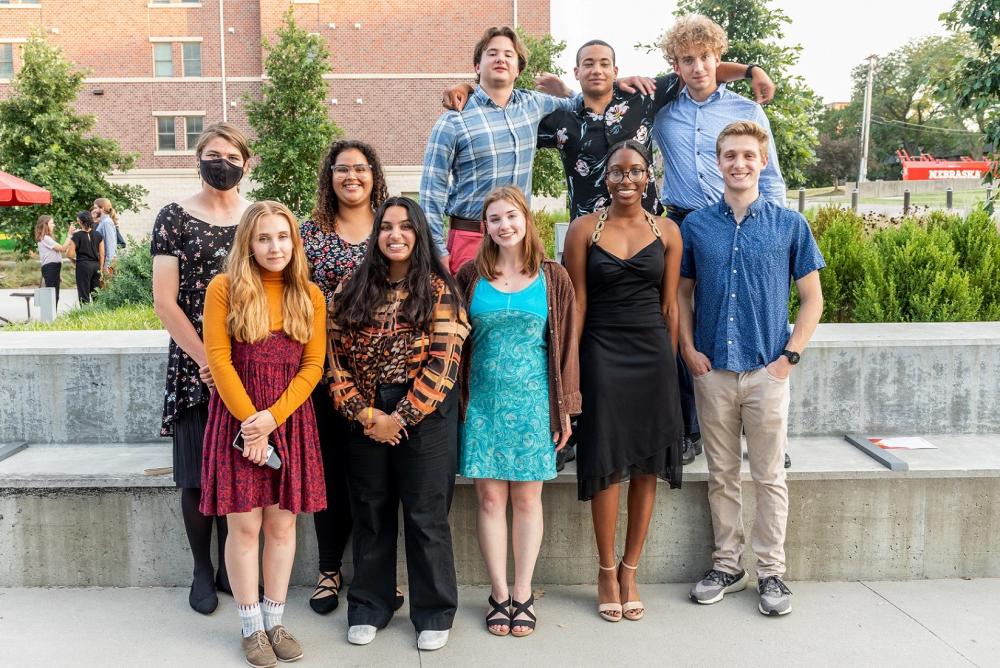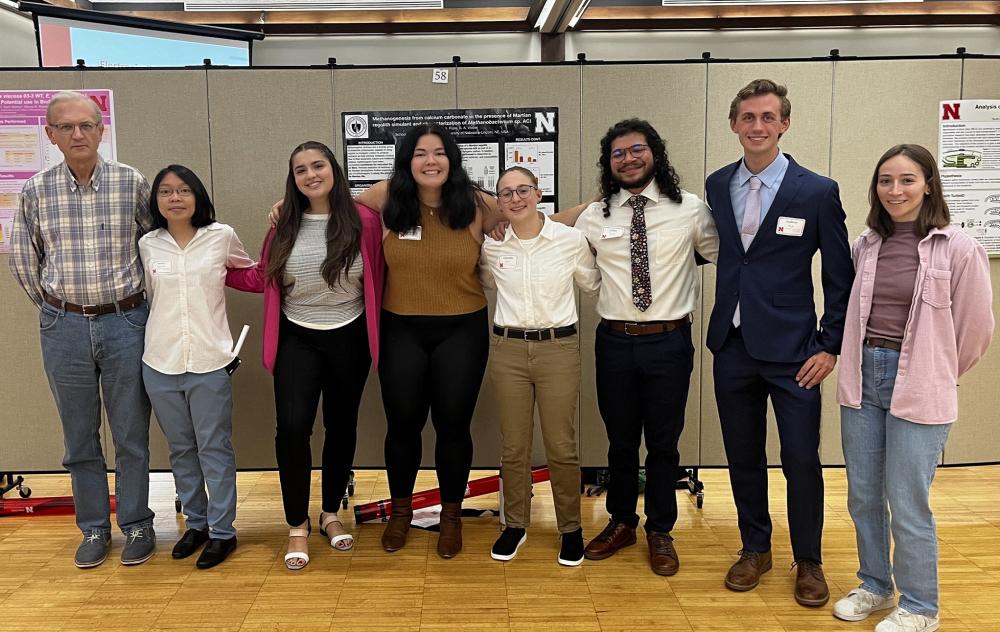
Study Bioenergy! The research of today for the solutions of tomorrow.
For information contact
Funding Source

Who should apply
Related fields
- Biology
- Biochemistry
- Microbiology
- Molecular Biology
- Plant Science
Applications are encouraged from students with sophomore standing or higher and a GPA of 3.0 or higher.
Eligibility
Participation in the Nebraska Summer Research Program is limited to students who meet the following criteria:- U.S. Citizen or Permanent Resident
- Current undergraduate with at least one semester of coursework remaining before obtaining a bachelor's degree
See Eligibility for more information.
How to apply
Follow the application steps to submit the following materials.
About the Program
One of the greatest challenges facing 21st-century society is finding a sustainable energy supply. Energy is the basis for a large portion of the global economy and we are currently primarily dependent on nonrenewable fossil fuels. Not only are reserves dwindling, but nonrenewable fossil fuels also contribute significantly to pollution and climate change. With adequate research and proper implementation, plants, algae, and other microorganisms have great potential to help address the energy crisis.
UNL’s Bioenergy Systems REU is funded by NSF and administered by the School of Biological Sciences. We collaborate with faculty mentors with seven departments as well as the Center for Plant Science Innovation to provide diverse research opportunities with laboratories covering a wide spectrum of bioenergy research topics. You are matched with a faculty mentor and participate actively in the design and implementation of a ten-week research project in order to contribute new knowledge to sustainable energy systems.

Bioenergy seminars and touring a local power plant provide opportunities to exchange ideas with other students, researchers, and faculty. The program offers graduate school and professional development seminars as well as social and recreational activities.
Benefits
- Competitive stipend: $5,500
- Suite-style room and meal plan
- Travel expenses to and from Lincoln
- Campus parking and/or bus pass
- Full access to the Campus Recreation Center and campus library system
- Wireless internet access
Learn more about academic and financial benefits.
Events
- Campus and department orientation
- Department seminars and presentations
- Professional development workshops (e.g., applying to graduate school, taking the GRE)
- Welcome picnic
- Day trip to Omaha's Henry Doorly Zoo and Aquarium
- Outdoor adventures
- Research symposium
Mentors and Projects
Dr. Nicole Buan Department of Biochemistry
Metabolic Engineering of Methane Production by Anaerobic Archaea
Natural gas provides up to 50% of all US domestic energy needs. It is primarily composed of methane and is an important fuel for transportation, heat, and generating electricity. Methane-producing archaea (methanogens) are naturally-occurring microbes found in the environment that can make methane from renewable biomass. The Buan lab is focused on engineering methanogens by manipulating the electron transport system to produce organisms that are suitable for industrial-scale production of methane as a renewable energy source.
Dr. Edgar Cahoon Department of Biochemistry & Center for Plant Science Innovation
Metabolic Engineering and Functional Genomics of Oilseed Crops for Improved Oil Content and Composition
We conduct research to modify lipid metabolism in oilseeds and algae to increase the oil content and improve fatty acid composition of vegetable oils for biofuels and biobased lubricants. Our research encompasses the use of metabolic engineering and synthetic biology for improvement oil and seed co-product traits in crops such as soybean and camelina. The research not only is aimed at outcomes to address world energy needs but also at providing basic insights into plant and algal fatty acid biosynthetic and metabolic pathways and their regulation. Our research is expected to improve the quality and content of oil in bioenergy feedstocks, including oilseeds and sorghum, and also generate high-value co-products to enhance the economic viability of bioenergy feedstocks.
Dr. Heriberto Cerutti School of Biological Sciences & Center for Plant Science Innovation
Algae as Energy Systems: Genomics, Metabolomics and Engineering
We are interested in improving, by genomics, genetics and biochemical means, the capability of algae to accumulate oil in order to create a reliable and sustainable source for the production of next generation biofuels. Undergraduate students participating in these projects will have the opportunity to learn a variety of genetic, metabolomics, synthetic biology and bioinformatics techniques; participate in the design, execution and interpretation of experiments; and contribute to publication in scientific journals.
Dr. Alan Christensen School of Biological Sciences
DNA Damage and Repair, Plant Mitochondrial Genomes, Repeats Of Unusual Size, Recombination
Dr. Jeff Mower Department of Agronomy & Horticulture & Center for Plant Science Innovation
Organelle Adaptation for Increased Cellular Bioenergetics
Developing algae for biofuels will place extreme energy demands on the cell, requiring increased efficiency and energy output from the mitochondria and chloroplasts. We are using tools of comparative genomics, molecular evolution, and molecular biology to identify the adaptive changes in mitochondrial and chloroplast genomes in response to the bioenergetic needs of oleaginous algae.
Dr. Kenneth Nickerson School of Biological Sciences
Physiological Aspects of Quorum Sensing in Eukaryotes
Our lab studies bacterial, fungal, and algal systems. Active areas of research include: fungal dimorphism in Candida albicans and Ceratocystis ulmi; farnesol as a quorum sensing molecule (QSM) produced by C. albicans; farnesol's mode of action as a QSM and as a virulence factor; anaerobic growth of C. albicans; urea metabolism in C. albicans and other fungi; biotinylated histones in C. albicans; chlamydospore formation in C. albicans; high cell density QSMs from diatoms and other algae; detergent resistance in algae; and microbial ecology of alkaline lakes in Western Nebraska.
Dr. Wei Niu Department of Chemical & Biomolecular Engineering
Microbial synthesis of chemicals from renewable feedstocks
Microorganisms are natural chemical factories at micrometer scale. The Niu lab focuses on applying systems metabolic engineering principles and synthetic biology tools to microbial hosts, such as E. coli and yeast, to achieve the microbial syntheses of diverse molecules ranging from biofuel to high value-added pharmaceutical intermediates. Students will be exposed to both wet-lab techniques, such as molecular cloning and protein purification, and computational tools for data analysis.
Dr. Wayne Riekhof School of Biological Sciences
Lipid biology, biochemistry and molecular biology of algae
Research in my lab focuses on using microbial eukaryotic model organisms as systems to study various aspects of lipid metabolism, including membrane lipid and fatty acid trafficking between organelles, the regulation of membrane lipid and triglyceride synthesis, and the regulation of lipid droplet assembly and morphology.
Dr. Rebecca Roston Department of Biochemistry & Center for Plant Science Innovation
Stress-triggered membrane remodeling as a learning platform for energy production in land plants
Formation and maintenance of the photosynthetic membrane and the responses of membranes to severe stresses are studied. These topics are relevant to improving crop engineering strategies resulting in healthier, more stable crop production. Students will have the opportunity to use techniques from basic plant growth to lipid quantification using gas chromatography and everything in between.
Dr. James Schnable Department of Agronomy & Horticulture & Center for Plant Science Innovation
Comparing the genomes and phenomes of grain crops in response to abiotic stresses
Using a combination of high throughput sequencing, comparative genomic and computer-vision based phenotyping, the Schnable lab works on developing new techniques to identify genetic differences between related crop species, and link specific changes in gene sequence or gene regulation to variation in abiotic stress tolerance between maize (corn) a highly productive but relatively stress sensitive crop and closely related species with higher levels of stress tolerance including other crop species such as sorghum and pearl millet, as well as wide species such as Paspalum vaginatum (a salt tolerant species that can grow right on the beach).
Dr. Karrie Weber School of Biological Sciences & Department of Earth & Atmospheric Sciences
Rock and the Role of Microorganisms in the Environment
Microorganisms are capable of utilizing a diversity of energy sources in the environment as such their metabolism has contributed to the production of bioenergy. Research in the Weber laboratory assesses and seeks to understand how these organisms take advantage of Earths minerals to produce energy as well as influence carbon, nitrogen, iron, and uranium cycling in aquatic, soil, and sedimentary environments.
Dr. Mark Wilkins Department of Biological Systems Engineering
Production of ethanol from Nebraska waste wood sources
Nebraska and other Central Plains states have experienced a massive spread of eastern redcedar trees that are disrupting traditional prairie ecosystems and degrading pasture land. Also, the emerald ash borer was recently found in Nebraska and will inevitably destroy Nebraska’s ash trees. Unfortunately, most of Nebraska’s eastern redcedar and ash trees have no lumber value; therefore, their current value is limited to providing heat through combustion. This project will look at using modified sulfite-based pretreatments to remove lignin from ash and redcedar wood. Then, the wood will be hydrolyzed enzymatically to produce fermentable sugars, which will be fermented to produce ethanol.